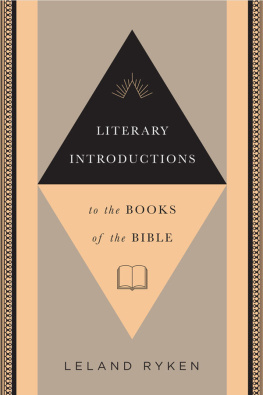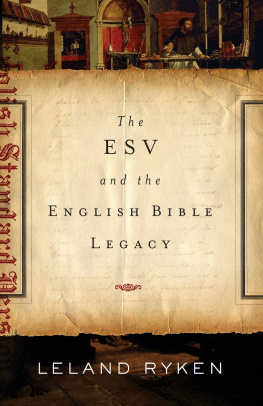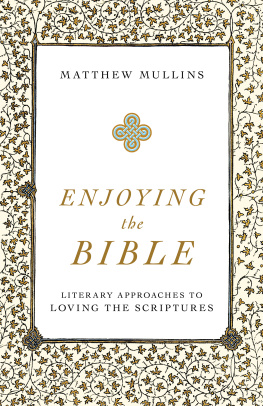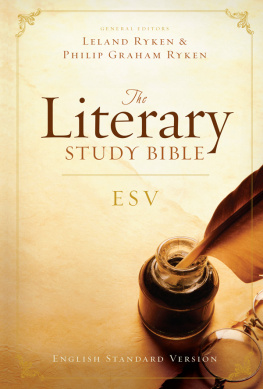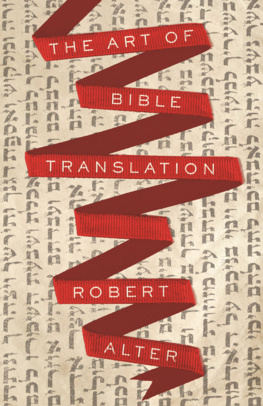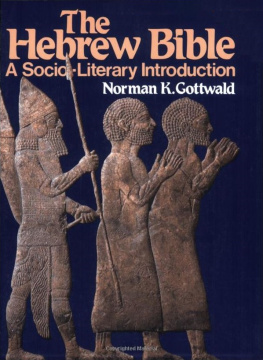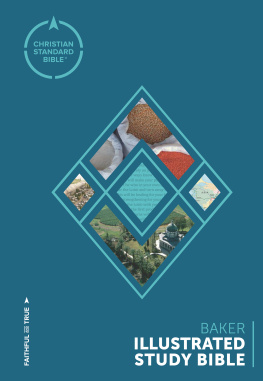Thank you for downloading this Crossway book.
Sign-up for the Crossway Newsletter for updates on special offers, new resources, and exciting global ministry initiatives:
Crossway Newsletter
Or, if you prefer, we would love to connect with you online:
LITERARY
INTRODUCTIONS
to the BOOKS
of the BIBLE
LELAND RYKEN

Literary Introductions to the Books of the Bible
Copyright 2015 by Leland Ryken
Published by Crossway
1300 Crescent Street
Wheaton, Illinois 60187
All rights reserved. No part of this publication may be reproduced, stored in a retrieval system, or transmitted in any form by any means, electronic, mechanical, photocopy, recording, or otherwise, without the prior permission of the publisher, except as provided for by USA copyright law.
Cover design: Dual Identity, Inc.
First printing 2015
Printed in the United States of America
Unless otherwise indicated, Scripture quotations are from the ESV Bible (The Holy Bible, English Standard Version), copyright 2001 by Crossway, a publishing ministry of Good News Publishers. Used by permission. All rights reserved.
Scripture quotations marked KJV are from the King James Version of the Bible.
Scripture references marked RSV are from The Revised Standard Version. Copyright 1946, 1952, 1971, 1973 by the Division of Christian Education of the National Council of the Churches of Christ in the U.S.A.
Trade paperback ISBN: 978-1-4335-4217-6
ePub ISBN: 978-1-4335-4220-6
PDF ISBN: 978-1-4335-4218-3
Mobipocket ISBN: 978-1-4335-4219-0

Library of Congress Cataloging-in-Publication Data
Ryken, Leland, author.
Literary introductions to the books of the Bible / Leland Ryken.
1 online resources.
Includes bibliographical references and index.
ISBN 978-1-4335-4218-3 (pdf) ISBN 978-1-4335-4219-0 (mobi) ISBN 978-1-4335-4220-6 (epub) ISBN 978-1-4335-4217-6 (trade paperback)
1. Bible as literature. I. Title.
BS535
220.6'6dc23 2015029256

Crossway is a publishing ministry of Good News Publishers.
For all my students and readers
who have caught a vision for
the Bible as literature
CONTENTS
This book is a literary introduction to all the books of the Bible as arranged in their canonical order. The focus is specific, namely, the literary forms that make up the shape and substance of the respective books of the Bible. This is slightly supplemented by other literary matters that are too important to omit from the discussion. With its focus on literary form, this is a companion and sequel to my A Complete Handbook of Literary Forms in the Bible; more complete descriptions of the Bibles literary forms appear in that volume.
In composing this book I have drawn in general ways upon the dozen books I have authored or edited on the Bible as literature. The three from which I have taken the most are Rykens Bible Handbook; The Literary Study Bible; and A Complete Handbook of Literary Forms in the Bible. I have incorporated the outlines of individual Bible books from The Literary Study Bible.
Why the Literary Forms of the Bible Are Important
We need to begin with a definition: the concept of literary form should be construed broadly as anything having to do with how the authors of the Bible expressed their content. The how of their communication extends from the very broad, such as the genres they used (e.g., narrative or poetry), to the small (e.g., techniques such as dramatic irony and metaphor).
Are the literary forms of the Bible sufficiently important to warrant a book devoted to that aspect of it? They are, for the following seven reasons.
1) In any piece of writing, there is no content without the form in which it is expressed. Without the story or poem, for example, there is no message. The content of the Bible does not exist in disembodied form; it is all embodied in a myriad of literary forms.
2) There is an important way in which an analysis of literary forms needs to come first when we interact with a biblical text. This is not a precedence of value or importance but of the order in which we master a text. If the message is embodied in a form, we first need to master the form. The how is the door that opens the what of the utterance. A summary of the message of a biblical book without a prior description of the genres and forms in which the message is packaged leaves us without a conception of the kind of book being described.
3) Paying attention to the forms of a biblical book ensures that we engage with the Bible itself. Much Bible study and published scholarship leapfrogs over the preliminary step of interacting with the text. How do we know if a given summary of ideas is correct if the basis of formulating the ideas has been removed from sight? We dont.
4) Everything that writers put into their composition is something they regarded as important, including the literary aspects of a text. If literary matters were important to the writers of the Bible, they need to be important to us as readers.
5) All literary forms have defining traits and methods of analysis. Not heeding these rules of the road is a recipe for misrepresenting the content of the Bible. I regularly find myself scratching my head about what a teacher or preacher or layperson says about a Bible passage, and usually the problem arises from lack of literary analysis. Even when the interpretation is not wrong, the focus is blurred because the best available tools have not been used. As a literary scholar I regularly find myself wanting to impart essential information to expositors and teachers of the Bible. This book is my opportunity to pass on that information.
6) It is a logical inference that if the writers of the Bible spoke from God as they were carried along by the Holy Spirit (2 Pet. 1:21), then God inspired the forms in which the writers composed. The literary forms of the Bible deserve an attention commensurate with their inspiration.
7) A literary approach to the Bible is required by three time-honored evangelical principles of hermeneutics. (1) Reading a text in keeping with what we can infer about the authors intention. Whenever a biblical author entrusted his utterance to a literary genre or form, we can infer that he intended us to assimilate his work by using all the ordinary methods of literary interpretation. (2) Doing justice to the specificity of a text. If a text is literary in nature, paying attention to its specific qualities requires us to interact with its literary traits. (3) Assimilating and interpreting a passage in terms of the kind of writing (genre) it is. The only way to assimilate a text in terms of its literary form is to pay close attention to the form or genre.
In all this emphasis on the literary forms of the Bible, we need to resist any impulse to think that when we see these forms in the Bible we have added something to the Bible. We have not added anything. We are discovering the forms that the authors put into their works and that are demonstrably there. The only question is whether we will do anything about what the authors have placed before us. This introduction to the books of the Bible is based on the premise of doing something with its literary forms.
Next page
